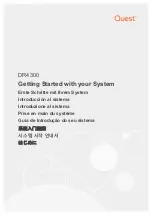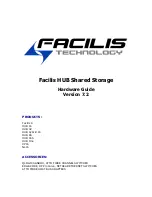
Seagate Enterprise Capacity 3.5 HDD v7 SAS Product Manual, Rev. C
38
* For read retry count, every tick ~ 5% of total error recovery. Valid range setting is 1-20.
e.g. 1 ~ 5%
5 ~ 25%
20 ~ 100%
Setting these retry counts to a value below the default setting could result in degradation of the unrecovered error rate. For example, suppose the
read/write recovery page has the RC bit = 0 and if the read retry count is set to 5, this means ~ 25% of error recovery will be executed which
consumes 621.62 ms (please refer to the table above). If the limit is reached and a LBA has not yet been recovered (i.e. requires retries beyond
621.62 ms), the command will end with Check Condition status report and unrecoverable read error will be reported.
8.3
SAS system errors
Information on the reporting of operational errors or faults across the interface is given in the
SAS Interface Manual
. The SSP Response returns
information to the host about numerous kinds of errors or faults. The Receive Diagnostic Results reports the results of diagnostic operations
performed by the drive.
Status returned by the drive to the initiator is described in the
SAS Interface Manual.
Status reporting plays a role in systems error management and
its use in that respect is described in sections where the various commands are discussed.
8.4
Deferred Auto-Reallocation
Deferred Auto-Reallocation (DAR) simplifies reallocation algorithms at the system level by allowing the drive to reallocate unreadable locations on a
subsequent write command. Sites are marked for DAR during read operations performed by the drive. When a write command is received for an
LBA marked for DAR, the auto-reallocation process is invoked and attempts to rewrite the data to the original location. If a verification of this rewrite
fails, the sector is re-mapped to a spare location.
This is in contrast to the system having to use the Reassign Command to reassign a location that was unreadable and then generate a write
command to rewrite the data. DAR is most effective when AWRE and ARRE are enabled—this is the default setting from the Seagate factory. With
AWRE and ARRE disabled DAR is unable to reallocate the failing location and will report an error sense code indicating that a write command is
being attempted to a previously failing location.
8.5
Idle Read After Write
Idle Read After Write (IRAW) utilizes idle time to verify the integrity of recently written data. During idle periods, no active system requests, the drive
reads recently written data from the media and compares it to valid write command data resident in the drives data buffer. Any sectors that fail the
comparison result in the invocation of a rewrite and auto-reallocation process. The process attempts to rewrite the data to the original location. If a
verification of this rewrite fails, the sector is re-mapped to a spare location.
Table 4
Read and write retry count maximum recovery time
Read retry count*
Maximum recovery time per
LBA (cumulative, ms)
Write retry count
Maximum recovery time per
LBA (cumulative, ms)
0
35.94
1
124.32
1
53.91
5
621.62
2
79.89
10
1243.23
3
97.86
15
1864.85
4
175.85
20 (default)
2486.47
5 (default)
421.79
















































